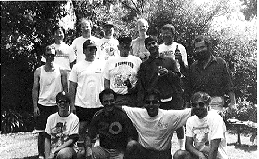Research


My work so far has been mostly in particle physics, but have worked in string theory as well as in statistical physics (spin-glasses) and in computer networks.
I finished my degree in 1989 with Prof. Leonard Kisslinger at Carnegie Mellon University. My thesis project was to construct a light-cone model for the pion. We wrote a Bethe-Salpeter equation on the light-cone for the pion amplitude. The Bethe-Salpeter kernel contained a confining piece and a perturbative one-gluon exchange piece, parameterized by two constants fixed by the charge mean square radius and the pion decay constant. This amplitude was then used to calculate the pion form factor at all values of the momentum transfer.
During my stay at SLAC I have been working on light-cone physics. I will briefly outline my past work in light-cone research and will focus then on what I am working presently . More detail on this work can be found in the papers listed in the Reference list and in the talks I have given.
The object of my recent interest has been quantization on the light-cone which preserves parity explicitly and which treats x^+ = t+z and x^-=t-z symmetrically. It turns out that the question of quantization can be posed as a initial value problem , which is what I am doing, or it can be looked at as a mixed initial value boundary problem, as does Heinzl and Werner (Regensburg preprint 93-3). I won't repeat my arguments regarding this work here. Let me point out here that this method I am employing is not new, actually . I have rediscovered a method initially proposed by Roger Penrose to study classical gravity. The point which he made and which is bourne out by my paper on gauge fields is that if one takes as initial surfaces x^+ =0 and x^- =0 as well as the region x^+ =x^- =0, then there are no constraints, equations which relate the initial data . What is new is the application of this approach to field theory. This work was reported recently in several papers.
This feature could have potential implications beyond light-cone physics. Furthermore, I have carried out calculations to one-loop for electron wave function and mass self-energy, as well as for photon wave function and mass self-energy, and was able to recover the standard covariant results. The vanishing of the photon mass to one-loop level is particularly simple in this approach, in contradistinction to other methods, on the front-form or in canonical quantization. What is gratifying is that for the first time in light-cone calculations, one calculation obtains all the covariant calculation results: all the coefficients, all the same divergences. I was also able to recover the usual Schwinger model results by a simple limiting technique.
At the moment I am applying this method ( which I dubbed null-surface quantization) to heavy quarks. I have been able to formulate heavy quark effective theory in this Penrose quantization and have computed the renormalization constants for both the full QCD theory and for the effective theory.I hope to be able to develop an effective theory for B-mesons in null-surface quantization.
I have written a paper on the energy of the vacuum with Ron Adler and Brandan Casey. Ron Adler and I have also been applying the null-surface quantization described above to Hawking radiation from black holes -- recently, there has been some work on the Web translating spacetimes from general relativity to VRML (Virtual Reality Modeling Language) mostly by the NCSA Relativity Group.
Near the event horizon of a black hole, the natural coordinates are null-coordinates, so it is quite natural that such coordinates should be used to describe the more details quantum physics of black holes. (A recent work by Susskind and Griffin does just that using standard light-cone quantization.)
I have also applied the phase-space quantization introduced by Faddeev and Jackiw, refined by Zhang and Harindranath, to chiral symmetry breaking in light-cone QCD.It turns out that discrete light-cone quantization (DLCQ) can be applied so a variety of theories besides the usual field theories, like matrix models. I applied this approach to a c=2 matrix model of non-critical strings.
During my stay at Los Alamos in 1992 I worked with Dharam Ahluwalia on applications of his generalization of the Dirac equation to j=3/2 composite. In particular, we studied the invariants one could measure in elastic scattering, like form factors.
At that time I also studied more phenomenological aspects of particle/nuclear physics. Dr. Goldman and I looked at breather modes for a quark model of baryons, which might tell us something about the nature of nuclear interaction.
Another project I worked on was the Gross-Neveu model, in the DLCQ approach introduced by Pauli and Brodsky. My main interest was in studying the nature of the QCD vacuum in this approach, since in the light-cone the vacuum is supposed to be simple. This study should also tell us something about the nature of dynamical symmetry breaking in the light-cone. It turned out that I needed to know more about including the zero modes in light-cone quantization. This was first discussed by Heinzl, Krusche and Werner. I applied it to the Yukawa model . In 1992 , Alex Langnau and I constructed an effective kernel for the Bethe-Salpeter equation for the positronium by considering up to five-state Fock states and considering kernels up to alpha^2 - to order alpha for now - which couple the different Fock states in a system of coupled integral equations. One of the first projects I studied at SLAC was a model for mesons with definite spin. One of the new ideas introduced here is to use a Melosh transformation with interactions rather than the usual non-interacting Melosh transformation which I had used on my thesis work with Prof. Kisslinger.There are also some unexpected connection I made with politics, as well as musick. Also, surprisingly, physics leads to a better appreciation of beauty and of the physical existence .
